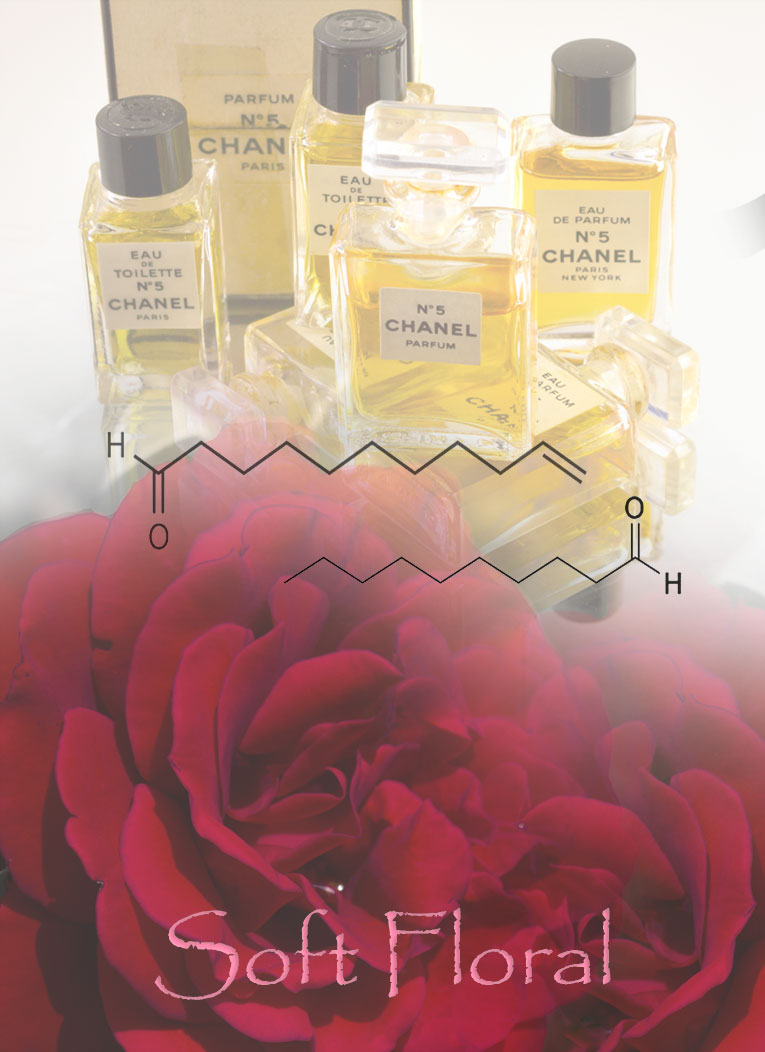Floral Aldehydic Perfumes or Soft Florals

Originally posted: http://blog.aromyth.nl/?p=170
Floral aldehydic is an interesting example of a perfume family originated from a group of aromachemicals. Technically speaking aldehydes are forming a huge group of chemical compounds containing a “formyl group”. It includes a very big group of perfume odorants. But only few of them are used as a reference for an aldehydic smell in perfumery. Mostly those are alifatic (or “fatty”) aldehydes with 10-12 carbon atoms like C10 (decanal), C11 (undecanal), C11 (undecylenic), C12 (lauric) or C12 (MNA). But there are no strict rules here as other aldehydes may be used as well.
Fatty aldehydes are not really pleasant odorants. Their smell can be described as waxy, fatty, soapy and candle-like with citrus, green, floral or metallic nuances. But when diluted and pared with florals they can bring a sparkle in the top, a soft fantasy floral note in the hart and a powdery nuance in the base of a perfume (often in combination with iris and vanilla).
The use of fatty aldehydes in perfumes goes all way back to the beginning of the 20th century. The most famous aldehydic floral created in 1921 is of course Chanel N5 often referred as the first aldehydic perfume. Chanel N5 might be the milestone of the aldeydic floral family, but the use of aldehydes is also mentioned in earlier creations like Quelques Fleurs by Houbigant from 1912.
Aldehydes are often associated with a fantasy or artificial smell. But they do occur in nature. Citrus peel for example may contain up to several percent of fatty aldehydes. In lesser quantities they can be found in herbs (especially coriander), flowers (rose for example), conifers. They form the products of burning and ironing (think of a just-snuffed candle smell and a fresh laundry feeling).
There are three major fragrance classifications used in perfumery: a H&R-Genealogy, classification of the French Perfumer’s Society (SFP-classification) and Fragrance Wheel by Michael Edwards. H&R Genealogy determines Floral Aldehydic group as a part of a bigger Floral Family. SFP-classification uses the similar approach. It defines Floral Aldehydic as a separate group of the Floral Family and assigns it with a B4 code. In earlier version of SFP-classification B5 code was used, which is a bit confusing when reading older books and reviews. The Fragrance Wheel of Michael Edwards doesn’t have Floral Aldehydic group, but uses the term Soft Florals instead to describe this fragrance family. Inside this group he also differentiates Citrus Fruity, Gourmand, Green, Iris, Musc, Marine and White Floral subgroups to emphasize different nuances of Soft Florals. The same perfume can be classified differently. Like My Sin by Lanvin belongs to B3 (floral bouquet) group according to SFP-classification, but is placed under Floral Aldehydic by the H&R-Genealogy.
The milestone aldehydic florals are: Chanel N5, Arpège by Lanvin, Je Reviens by Worth, Calèche by Hermès, Madame Rochas, Climat by Lancôme, Calandre by Paco Rabanne, Chamade by Guerlain, Nocturnes by Caron, Estée by Estée Lauder.
 AromaX 10 years ago
AromaX 10 years ago
 Seraphima 10 years ago
Seraphima 10 years ago
 AromaX 10 years ago
AromaX 10 years ago
 ScentFan 10 years ago
ScentFan 10 years ago

